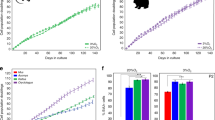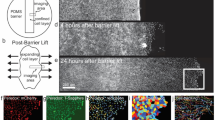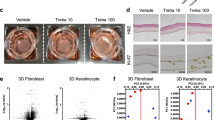Abstract
STIMULATION to tissue repair in wound healing has been attributed variously to polypeptides and amino-acids1, sulphhydryl compounds2, nucleoproteins3, fatty acids4, or certain nucleic acid derivatives5, and it has been proposed that the stimulating substances are secretions of leucocytes (“rephones” 1) or damaged-cell disintegration products (“wound hormones” 13). Since cell secretions or damaged-cell products influence normal cells through the intercellular milieu, a direct and quantitative approach to this problem is afforded by the comparison of intercellular fluids from damaged cells (I) and from normal cells (II), with regard to their chemical composition and effects on cell metabolism. Such comparisons have shown that (I) greatly exceeds (II) in stimulating cellular proliferation6,7 and respiration8,9 and in increasing capillary permeability10, and that when (I), but not (II), from animal tissue sources is injected repeatedly into animals, overgrowths result7.
This is a preview of subscription content, access via your institution
Access options
Subscribe to this journal
Receive 51 print issues and online access
$199.00 per year
only $3.90 per issue
Buy this article
- Purchase on Springer Link
- Instant access to full article PDF
Prices may be subject to local taxes which are calculated during checkout
Similar content being viewed by others
References
Carrel, A., J. Exp. Med., 36, 385 (1923); J. Amer. Med. Assoc., 82, 255 (1924).
Hammett, F. S., Cold Spring Harbor Symposia Quant. Biol., 2, 78 (1934).
Fischer, A., NATURE, 144, 112 (1939).
Bonner, J., and English, T., jun., Science, 86, 352 (1937).
Calkins, G. L., Bullock, F. D., and Rohdenberg, G. L., J. Infect. Dis., 10, 221 (1912).
Loofbourow, J. R., Dwyer, C. M., and Lane, M. M., Biochem. J., 34, 432 (1940); Loofbourow, J. R., Dwyer, C. M., and Cronin, A. G., Biochem. J., 35, 603 (1941); Loofbourow, J. R., Cook, E. S., and Stimson, M. M., NATURE, 142, 573 (1938); Davidson, J. N., Biochem. J., 34, 1537 (1940).
Menkin, V., Cancer Research, 1, 548 (1941); Loofbourow, J. R., Cueto, A. A., Whalen, D., and Lane, M. M., NATURE, 144, 939 (1939).
Fardon, J. C., Carrol, M. J., and Ruddy, M. V., Studies Inst. Divi Thomae, 1, 35 (1938).
Sizer, I. W., and Loofbourow, J. R., to be published.
Menkin, V., J. Exp. Med., 67, 129 (1938); "Dynamics of Inflammation" (The Macmillan Company, N.Y., 1940).
Loofbourow, J. R., Biochem. J., in the press.
One growth unit corresponds to an increased 24-hour yeast crop in Reader's medium of approximately 1,000 per cent ascompared with the controls, under the standard assay conditions employed, Loofbourow, J. R., Webb, A. M., Abramowitz, R. K., and Loofbourow, D. G., Biochem. J., in the press.
Wiesner, J., "Elementarstruktur" (Vienna, 1892): Haberlandt, G., Sitz. preuss. Akad. Wiss., 221 (1921); Beitr. Allgem. Botan., 2, 1 (1921); Biol. Zentr., 2, 145 (1921).
Loofbourow, J. R., and Stimson, M. M., J. Chem, Soc., 844 (1940).
The supplements were computed to afford an excess of each factor from data of Williams, R. J., Eakin, R. E., and Snell, E. E., J. Amer. Chem. Soc., 62, 1204 (1940).
Cook, E. S., personal communication and Studies Inst. Divi Thomae, in publication.
Webb, A. M., to be published.
Loofbourow, J. R., Webb, A. M., and Abramowitz, R. K., NATURE, 149, 278 (1942).
Fleisehmann, W., Cold Spring Harbor Symposia Quant. Biol., 7, 290 (1939).
Reader, V., Biochem. J., 21, 901 (1927).
Author information
Authors and Affiliations
Rights and permissions
About this article
Cite this article
LOOFBOUROW, J. Role of Adenine Nucleotides and Growth Factors in Increased Proliferation following Damage to Cells. Nature 150, 349–350 (1942). https://doi.org/10.1038/150349c0
Issue Date:
DOI: https://doi.org/10.1038/150349c0
This article is cited by
Comments
By submitting a comment you agree to abide by our Terms and Community Guidelines. If you find something abusive or that does not comply with our terms or guidelines please flag it as inappropriate.



